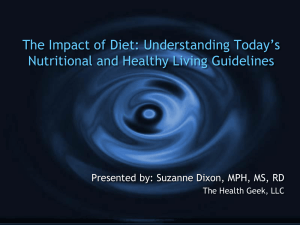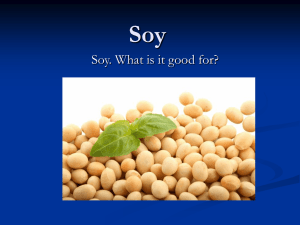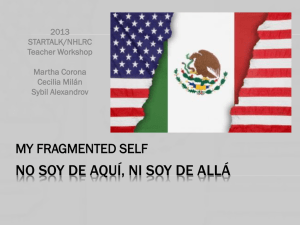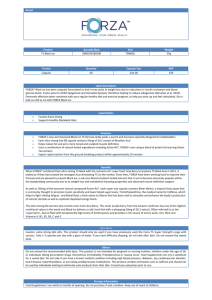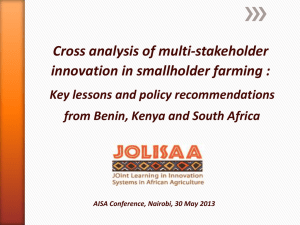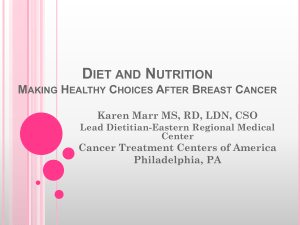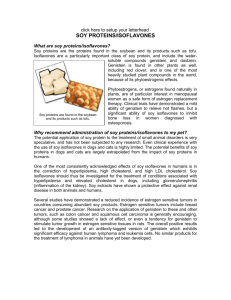Investigating New Trends in Cancer Prevention
advertisement
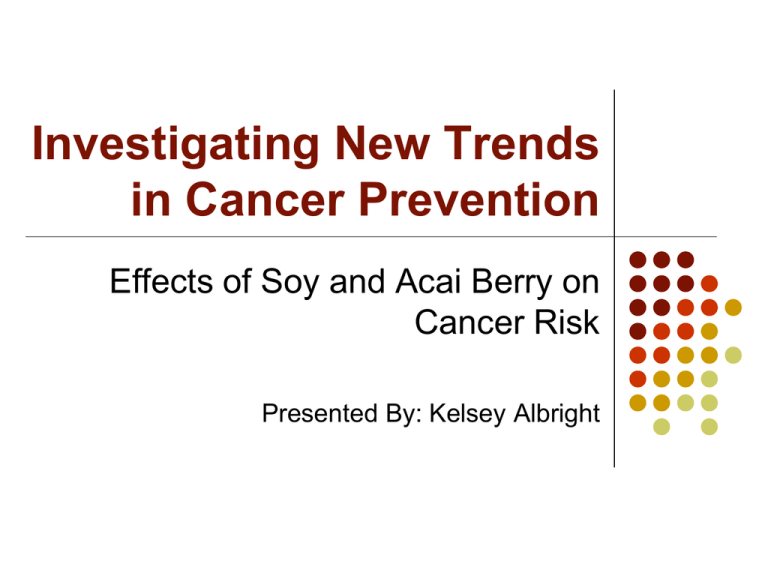
Investigating New Trends in Cancer Prevention Effects of Soy and Acai Berry on Cancer Risk Presented By: Kelsey Albright Do you think consuming soy products will increase or decrease risk of cancer? What is Soy? Bean & legume Forms: Whole beans Flour Processed Soymilk, tofu, cheese, soybean oil, yogurt, miso, tempeh, etc. Soy Nutrition Depends on form Unprocessed vs. processed Good source of protein ~40% of calories Vegetarians Ca lor ies Prote in CHO F at Mat u re So y bea n s (y ell o w ), cooked 149 14.3 8.5 7.7 So y bea n s, g ree n (eda m am e) 127 11.1 10.0 5.8 Te m pe h 165 15.8 14.1 6.4 So ynu ts 194 17.0 14.1 9.3 To fu , firm 183 19.9 5.4 11.0 So y fl o u r, de fatted 82 11.8 9.6 0.3 So y mi lk 100 7 .0 8.0 4.0 M iso 71 4.1 9.7 2.1 What Does Soy Have to Do With Cancer? Research has shown Asian populations have lower incidences of cancers Key component: isoflavons Genitstein, daidzein, & glycitein Effects are similar to estrogen Caused concern for women with high risk Focus on breast health Estrogen Navigating the Information Most use google and wikipedia Look for .org; .edu; & .gov General information What is soy? But…be cautious Site biases, & falsified information Specific nutritional benefits & consequences More credible Go to the source! Does it have a link to a journal article? Read abstract Research “Childhood Soy Intake and Breast Cancer Risk in Asian American Women” Participants: Asian American women previously diagnosed with breast cancer Method: interviews with women and mothers Lifestyle and historical questions Dietary intake of soy during childhood, adolescence, and adulthood Results: S oy Intake C hil dhoo d (m ot her inter viewed) L ow Med ium H igh A dolesce nce (su bjec t inter viewed) L ow Med ium H igh A du lthoo d (su bjec t inter viewed) L ow Med ium H igh Cas e s/C ontrols RR (95% CI m ode l ) full y ad jus ted 41/50 30/51 26/52 1.0 0.4 3 0.4 215/315 186/303 175/324 1.0 0.95 0.80 205/298 222/339 164/325 1.0 0.99 0.76 Soy consumption during childhood may be preventative against breast cancer Research “Soy May Fuel Estrogen-Positive Breast Cancer” Estrogen sensitive breast cancer stimulated by estrogen Genistein mimics effects of estrogen Speeds growth of tumors “…I am concerned about the woman with a estrogendependent cancer…She needs to be very careful about the amount of soy isoflavones she consumes” William G. Helferich Research American Chemical Society (2004) Similar results Study performed in cell cultures Addition of isoflavones genistein and daidzein to estrogen-sensitive breast cancer cells Results: Products of isoflavones caused damage to the DNA of these cells Initiated tumor growth & progression Soy and Breast Cancer Difficult to research and find a conclusive result because… Results vary depending on: Ethnicity of participants Cancer status of participants Asian, American, or Asian-American Before, during, or after cancer Age of participants Pre- or postmenopause What Do You Think? Do you think soy is good or bad? Would you include or increase soy in your diet? Why or why not? NEITHER: Soy is Not Good or Bad No conclusive argument or recommendation More research needed Studies in cell culture and animals show negative effects Unsure if human studies will show same results Soy in moderation Use your best judgment Acai Berry and Cancer Research Do you think acai berry increases, decreases, or has no effect on cancer risk? What is the Acai Berry? Euterpe oleracae Fruit of the Amazon palm tree Pulp or freeze-dried powder forms “Superfood” Cardiovascular & digestive health, energy, & anti-aging Dr. Perricone on the Oprah Winfrey Show Nutritional Composition of Acai 100 g Freeze-Dried Acai Berries have many healthy nutritional components High in vitamins, minerals, and fiber; low in calories Acai is a berry Fiber, vitamin A, iron, calcium, anthocyanins, proanthocyanidins, and flavonoids Ca lories Ca lories from fat T ot al fat Sa tura ted fat C holes ter ol Sodium T ot al car bohydra te D ietar y fi ber Sugars Prot ein V itami n A V itami n C Ca lcium Ir on 544.9 kca l 292.6 kca l 32.5 g 8.1 g 13.5 M g 30.4 M g 52.2 g 44.2 g 1.3 g 8.1 g 1002 IU <0.1 Mg 260.0 Mg 4.4 Mg What Does Acai Have To Do With Cancer? American Chemical Society Report High antioxidant content Reduces stress on the body caused by oxidation Oxidation produces free radicals Antioxidants remove free radicals caused by oxidation Factors causing oxidation Digestion of food, pollution, cigarette smoking, radiation, and herbicides High anthocyanin content linked to anticancerous effects Research Pharmaceutical Research Journal (2010) Methods: Performed in rats Fed one of 7 berry types Measurement of number, and sizes of tumors present in esophagus Measurement of antioxidant capacities of 7 berries Results: Diet Control Control + 5% Black Raspberries Control + 5% Blueberries Control + 5% Strawberries Control + 5% Red Raspberries (WGO2) Control + 5% Red Raspberries (Meeker) Control +5% noni Control + 5% wolfberry Tumor Incidence (%) 95 60 Tumor Multiplicity 2.15 1.07 63 75 1.00 1.25 75 1.19 63 0.88 60 63 1.10 0.94 Control + 5% acai 75 1.19 All berry types reduced number & multiplicity of tumors Antioxidant capacity was similar Anthocyanins & proanthocyanidins are key chemopreventative components Recommendations: Ignore online scams and claims for fast weight loss and energy Keep in mind that it is a fruit… But more research is needed Incorporate acai into your diet don’t go overboard choose a sugar-free acai pulp Make an Educated Decision Tips: Determine the most reliable sources Credible websites & journal articles Ask a professional! Understand both sides of the issue Gradually include soy/acai into your diet Rule of thumb: everything in moderation! Recognize Error Google search results Be wary of .com sites- anyone can create Sites that strongly encourage or discourage soy and acai berry consumption Product websites Example: promotion or advertisements of soy & acai bias No absolute evidence for a recommendation of intake Focus will always be on benefits News stories Usually based on credible research, but must dig deeper to uncover all the facts Recognizing Error in Journal Articles Cell Cultures Animals Provide a simulated environment Cannot replicate conditions that would occur naturally Similar genetic make-up to human, but not exact Susceptibility to tumors Humans Confounding factors Genetic predispositions Lifestyle factors

